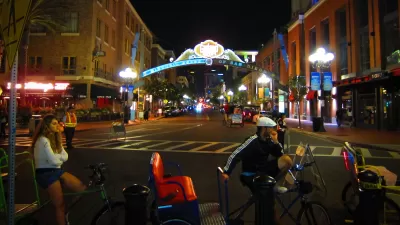San Diego's downtown, dominated by 3-lane one-way streets engineered to maximize car velocity and traffic flow, may be getting redesigned to make it hospitable for bicyclists and pedestrians.

Downtown San Diego's street grid could have made Jane Jacobs proud with its short blocks and multiple cross-streets. Unfortunately, most of that public right of way has been engineered solely for automobile-mobility, with one-way three-lane streets, timed traffic lights, the resultant high speed traffic, parallel parking, and aggressive (and costly) jaywalking enforcement. The auto-oriented street grid leaves little room for cyclists and is inhospitable for walkers, despite the fact that Downtown San Diego's small blocks and concomitant greater number of streets leave ample room to accommodate all modes of mobility.
All that could soon change. The city has issued a draft of the Downtown San Diego Mobility Plan, years in the making, "with a goal of reducing travel by car and increasing trips by bike and foot" writes dedicated downtown urbanist Bill Keller. Among the features contained in the plan,
Perhaps the most ambitious idea is the network of Bike Paths, Lanes, Routes and Cycle Tracks detailed in Chapter 5 Bicycling. For example, a two-way cycle track separated from traffic would run along the west side of Sixth Ave from Beech St down to L St. Cycle tracks are also proposed along sections of Pacific Highway, State St, Park Blvd, Grape St, Hawthorne, Beech, Broadway, C St, and J St.
A public workshop is scheduled for February 23rd and the public review period is open until March 11, 2016. Comments may be submitted at the Mobility Plan website.
FULL STORY: Downtown San Diego Mobility Plan — Draft Released

Alabama: Trump Terminates Settlements for Black Communities Harmed By Raw Sewage
Trump deemed the landmark civil rights agreement “illegal DEI and environmental justice policy.”

Study: Maui’s Plan to Convert Vacation Rentals to Long-Term Housing Could Cause Nearly $1 Billion Economic Loss
The plan would reduce visitor accommodation by 25% resulting in 1,900 jobs lost.

Why Should We Subsidize Public Transportation?
Many public transit agencies face financial stress due to rising costs, declining fare revenue, and declining subsidies. Transit advocates must provide a strong business case for increasing public transit funding.

Wind Energy on the Rise Despite Federal Policy Reversal
The Trump administration is revoking federal support for renewable energy, but demand for new projects continues unabated.

Passengers Flock to Caltrain After Electrification
The new electric trains are running faster and more reliably, leading to strong ridership growth on the Bay Area rail system.

Texas Churches Rally Behind ‘Yes in God’s Back Yard’ Legislation
Religious leaders want the state to reduce zoning regulations to streamline leasing church-owned land to housing developers.
Urban Design for Planners 1: Software Tools
This six-course series explores essential urban design concepts using open source software and equips planners with the tools they need to participate fully in the urban design process.
Planning for Universal Design
Learn the tools for implementing Universal Design in planning regulations.
Caltrans
Smith Gee Studio
Institute for Housing and Urban Development Studies (IHS)
City of Grandview
Harvard GSD Executive Education
Toledo-Lucas County Plan Commissions
Salt Lake City
NYU Wagner Graduate School of Public Service


























